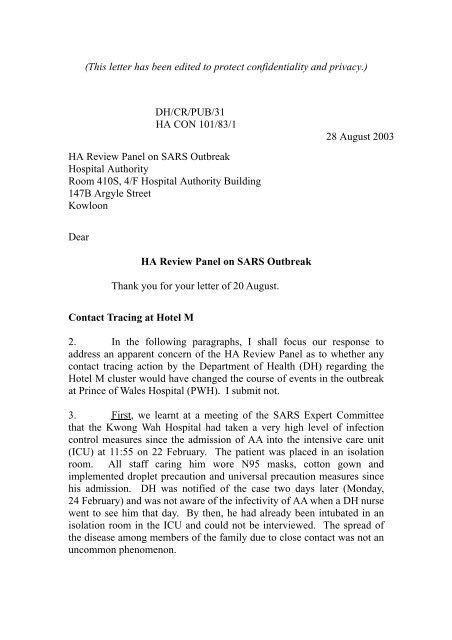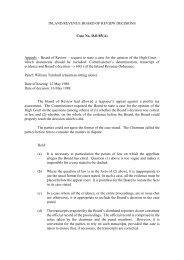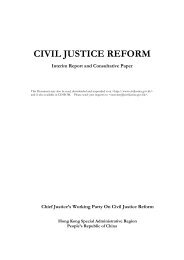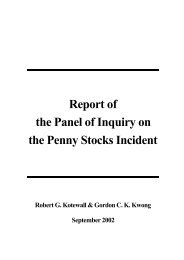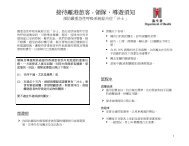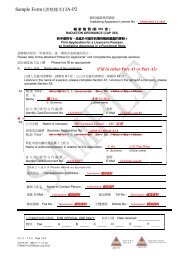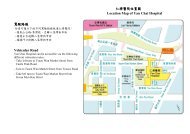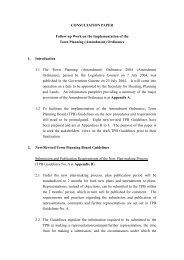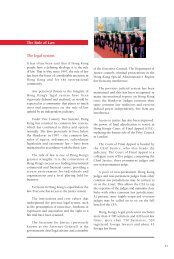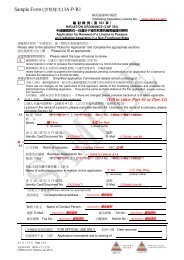Letter to HA Review Panel
Letter to HA Review Panel
Letter to HA Review Panel
You also want an ePaper? Increase the reach of your titles
YUMPU automatically turns print PDFs into web optimized ePapers that Google loves.
(This letter has been edited <strong>to</strong> protect confidentiality and privacy.)<br />
DH/CR/PUB/31<br />
<strong>HA</strong> CON 101/83/1<br />
28 August 2003<br />
<strong>HA</strong> <strong>Review</strong> <strong>Panel</strong> on SARS Outbreak<br />
Hospital Authority<br />
Room 410S, 4/F Hospital Authority Building<br />
147B Argyle Street<br />
Kowloon<br />
Dear<br />
<strong>HA</strong> <strong>Review</strong> <strong>Panel</strong> on SARS Outbreak<br />
Thank you for your letter of 20 August.<br />
Contact Tracing at Hotel M<br />
2. In the following paragraphs, I shall focus our response <strong>to</strong><br />
address an apparent concern of the <strong>HA</strong> <strong>Review</strong> <strong>Panel</strong> as <strong>to</strong> whether any<br />
contact tracing action by the Department of Health (DH) regarding the<br />
Hotel M cluster would have changed the course of events in the outbreak<br />
at Prince of Wales Hospital (PWH). I submit not.<br />
3. First, we learnt at a meeting of the SARS Expert Committee<br />
that the Kwong Wah Hospital had taken a very high level of infection<br />
control measures since the admission of AA in<strong>to</strong> the intensive care unit<br />
(ICU) at 11:55 on 22 February. The patient was placed in an isolation<br />
room. All staff caring him wore N95 masks, cot<strong>to</strong>n gown and<br />
implemented droplet precaution and universal precaution measures since<br />
his admission. DH was notified of the case two days later (Monday,<br />
24 February) and was not aware of the infectivity of AA when a DH nurse<br />
went <strong>to</strong> see him that day. By then, he had already been intubated in an<br />
isolation room in the ICU and could not be interviewed. The spread of<br />
the disease among members of the family due <strong>to</strong> close contact was not an<br />
uncommon phenomenon.
- 2 -<br />
4. Second, the fact that a number of persons related <strong>to</strong> AA had<br />
fallen sick appeared <strong>to</strong> be an intra familial spread due <strong>to</strong> close contact<br />
(paragraph 30 of my last letter refers). There was no environmental<br />
fac<strong>to</strong>r supporting a case for initiating contact tracing at Hotel M. This<br />
notwithstanding, Dr Margaret Chan, my predecessor, was concerned and<br />
had many discussions with one of the attending physicians and the<br />
Consultant of the Government Virus Unit <strong>to</strong> explore further actions<br />
required for identifying the causative agent.<br />
5. Third, as explained in the note in paragraph 18 of my last letter,<br />
as at 8 March, the illnesses of the three <strong>to</strong>urists from Singapore improved<br />
with antibiotics treatment and labora<strong>to</strong>ry investigations were pending.<br />
There was then insufficient evidence that their illnesses were related <strong>to</strong><br />
Hotel M. We therefore asked the Singapore Ministry of Health <strong>to</strong> keep us<br />
posted of any positive labora<strong>to</strong>ry findings and moni<strong>to</strong>red the development<br />
there.<br />
6. Fourth, JJ was initially suspected as the index case for the PWH<br />
cluster on 13 March and it was confirmed on 14 March. He had onset of<br />
symp<strong>to</strong>ms on 24 February and was hospitalized on 4 March (paragraphs<br />
21 and 66-69 of my letter of 18 August refer). Thus, even had DH<br />
initiated case investigation in Hong Kong on 8 March, it would not have<br />
any effect on the course of events in the outbreak at PWH. Neither would<br />
we be able <strong>to</strong> identify JJ earlier as he was not a guest in Hotel M at the<br />
material time. It was only on repeated questioning that he admitted that<br />
he had visited a friend in Hotel M around that period.<br />
7. Fifth, I can advise that the wife of the American Chinese did<br />
not tell us that her husband had stayed in Hotel M. She did not have full<br />
details of her husband’s travel his<strong>to</strong>ry.<br />
8. Sixth, the St Paul’s Hospital (SPH) cluster index case was not a<br />
severe community acquired pneumonia (SCAP) case when admitted <strong>to</strong><br />
SPH on 2 March. DH was notified on 13 March when the index case<br />
became a SCAP case. DH learnt of his stay in Hotel M from the index<br />
case himself during case interview / contact tracing on 14 March.<br />
9. Finally, there was no clinical SARS case among staff at<br />
Hotel M. The one admitted <strong>to</strong> Yan Chai Hospital during 2-11 March had<br />
a diagnosis of bacterial pneumonia and he subsequently recovered.<br />
We are committed <strong>to</strong> providing quality client-oriented service
- 3 -<br />
Amoy Gardens Index Patient – YY<br />
10. You have asked about the policy at the material time regarding<br />
follow up of patients discharged from PWH Ward 8A. The agreement<br />
with PWH was that the hospital would make available <strong>to</strong> DH a daily<br />
master list of persons for case investigation / contact tracing. DH would<br />
look in<strong>to</strong> every person on the master list (whether discharged or not) and<br />
take appropriate follow up action, although DH’s understanding was that<br />
PWH Ward 8A was closed <strong>to</strong> admission and discharge (paragraph 38 of<br />
my last letter refers). The follow up action taken by DH is illustrated by<br />
the Amoy Gardens index patient case described below.<br />
11. YY first appeared in the master list referred by PWH <strong>to</strong> DH in<br />
the evening of 16 March. After sorting out newly reported cases from old<br />
cases, DH staff embarked on case investigation on 17 March. The normal<br />
practice was that DH started with the more serious cases. We also<br />
discussed with PWH colleagues the latest clinical conditions of persons<br />
referred <strong>to</strong> us in the master list. It was likely that by the time we were <strong>to</strong><br />
interview YY, he had already been tested positive for influenza A. Hence<br />
no follow up action was required. As pointed out in my last letter, it was<br />
PWH which <strong>to</strong>ok action <strong>to</strong> drop YY from the master list subsequently.<br />
This was only a logical decision following the influenza A diagnosis and<br />
was a clear indication that PWH also did not consider it necessary for DH<br />
<strong>to</strong> follow up on YY. There was no indication from PWH that YY was<br />
discharged home on 19 March. We learnt this on 23 March when DH<br />
conducted a case interview with YY upon notification by PWH.<br />
Flight CA112 and Flight CA 115<br />
12. As mentioned in Annex 6 of my last letter, DH initiated active<br />
case investigation on the same day upon receipt of notification on<br />
23 March. Passenger lists obtained from the airline contained very<br />
limited information for tracing the passengers. We therefore sought the<br />
assistance of the Immigration Department and the <strong>to</strong>ur agencies with a<br />
view <strong>to</strong> obtaining contact information of as many passengers as possible.<br />
A public announcement was also issued <strong>to</strong> appeal <strong>to</strong> the passengers <strong>to</strong><br />
contact the DH hotline.<br />
13. Based on information on travel documents and nationalities<br />
reported, non-local passengers were identified from the lists and the<br />
relevant health authorities/consulates were duly informed <strong>to</strong> take<br />
appropriate action for follow up. The aforesaid group was not counted<br />
We are committed <strong>to</strong> providing quality client-oriented service
- 4 -<br />
<strong>to</strong>wards passengers contacted by DH. Moreover, despite meticulous<br />
checking and verification, information on some passengers was still<br />
incomplete, obsolete or unavailable, hence making contact impossible.<br />
Nonetheless, DH had taken a proactive and resourceful approach and had<br />
exercised professionalism and due diligence in tracing the passengers for<br />
surveillance.<br />
The Union Hospital - BB<br />
14. You have also asked about the SARS case of BB. Our<br />
investigation indicated that one travel collateral of BB also contracted<br />
SARS. Later on, DH was notified that a nurse EE who had cared for BB<br />
got the disease. All three eventually recovered. There was also another<br />
nurse who was admitted <strong>to</strong> PWH on 1 March for gastrointestinal tract<br />
symp<strong>to</strong>ms and that was not a SARS case. More details about our case<br />
investigation / contact tracing action are provided in the following<br />
paragraphs.<br />
15. On 22 February, DH was notified of BB’s admission in<strong>to</strong> PWH<br />
ICU as a SCAP case. DH initiated case investigation and contact tracing<br />
on the same day.<br />
16. BB was an American Chinese living in the US for more than 10<br />
years. She came back <strong>to</strong> Hong Kong on 30 January 2003 and travelled <strong>to</strong><br />
Henan, Guangzhou <strong>to</strong> visit a relative from 31 January <strong>to</strong> 17 February.<br />
BB developed fever and cough on 16 February while in Guangzhou. Her<br />
symp<strong>to</strong>ms persisted after consulting doc<strong>to</strong>r in the Mainland and she was<br />
admitted <strong>to</strong> the Union Hospital on the day of return from Guangzhou on<br />
17 February. Chest X-ray findings were compatible with pneumonia.<br />
She was transferred <strong>to</strong> PWH on 22 February and recovered eventually.<br />
Serological tests later confirmed her as a SARS case.<br />
17. Four relatives from Hong Kong joined BB in the visit <strong>to</strong><br />
Guangzhou. Contact tracing revealed that one of them developed SARS.<br />
A relative who had fever and cough on 21 February was admitted <strong>to</strong> the<br />
Prince Margaret Hospital (PMH) from 22 <strong>to</strong> 24 February and re-admitted<br />
on 26 February. She recovered eventually and was later confirmed <strong>to</strong> be<br />
suffering from SARS.<br />
18. On 28 February, DH was notified of the admission of EE <strong>to</strong><br />
PMH as a SCAP case. DH immediately initiated case investigation and<br />
contact tracing action.<br />
We are committed <strong>to</strong> providing quality client-oriented service
- 5 -<br />
19. Case investigation revealed that EE was a nurse in the Union<br />
Hospital who had cared for BB daily during 17-22 February. She<br />
developed malaise on 22 February followed by myalgia, cough, fever and<br />
chills two days later. She was admitted in<strong>to</strong> PMH on 27 February and<br />
subsequently recovered. Serological tests later confirmed her as a SARS<br />
case. None of her eight close contacts developed symp<strong>to</strong>ms. DH also<br />
contacted the Union Hospital on 28 February for medical surveillance of<br />
staff and patients exposed <strong>to</strong> BB and EE, and noted that none of the<br />
contacts developed symp<strong>to</strong>ms.<br />
20. I hope you find the above information useful.<br />
Yours sincerely,<br />
SIGNED<br />
(Dr P Y Lam)<br />
Direc<strong>to</strong>r of Health<br />
We are committed <strong>to</strong> providing quality client-oriented service


